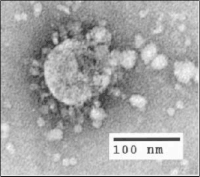
Photo from wikipedia
The aim of the present study was to investigate the clinical features and laboratory parameters of hospitalized patients with coronavirus disease 2019 (COVID-19) and assess the characteristics between severe and… Click to show full abstract
The aim of the present study was to investigate the clinical features and laboratory parameters of hospitalized patients with coronavirus disease 2019 (COVID-19) and assess the characteristics between severe and non-severe cases. The study retrospectively analyzed the clinical data of 1,096 patients, of which, 626 (57.11%) and 470 (42.89%) were categorized into severe and non-severe groups, respectively. Clinical parameters such as signs and symptoms, comorbidities, levels of D-dimer, C-reactive protein (CRP), interleukin 6 (IL-6) and lactate dehydrogenase were analyzed. The data are presented as frequencies, means and standard deviations. The chi-square test and Mann-Whitney U test were used to assess any significant differences between the severe and non-severe COVID-19 groups. The clinical symptoms in severe COVID-19 cases included anosmia (P≤0.01), sore throat (P≤0.01), fatigue (P≤0.01), headache (P≤0.01), and shortness of breath (P≤0.01). Laboratory findings showed a significant increase in CRP (21.90±40.23 vs. 16.13±21.82; P≤0.01) and IL-6 levels (58.92±55.07 vs. 41.41±38.30; P≤0.01). Patients with severe COVID-19 had significant lymphopenia compared with that in non-severe cases. Among the comorbidities, hypertension (P≤0.01) was significantly more frequent in patients with severe COVID-19. In conclusion, major derangements in laboratory parameters were observed in patients with severe COVID-19 infection.
Journal Title: Biomedical Reports
Year Published: 2022
Link to full text (if available)
Share on Social Media: Sign Up to like & get
recommendations!